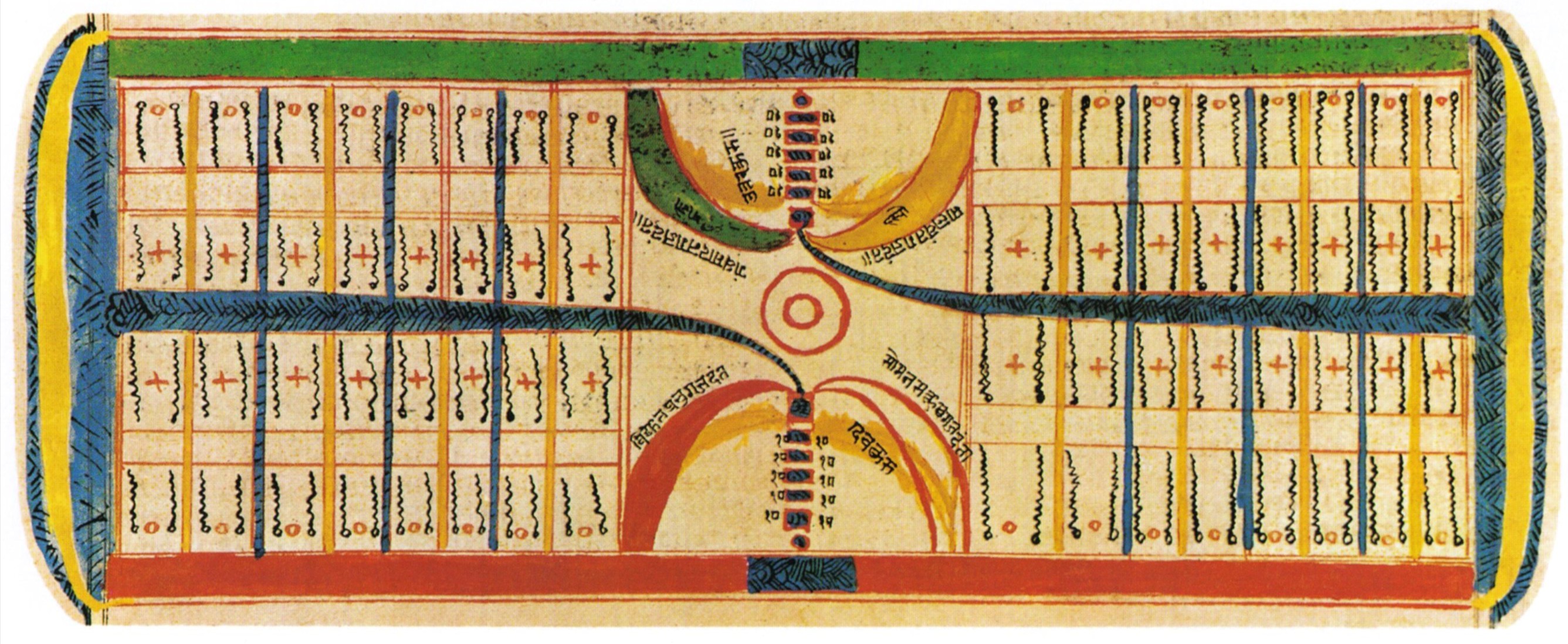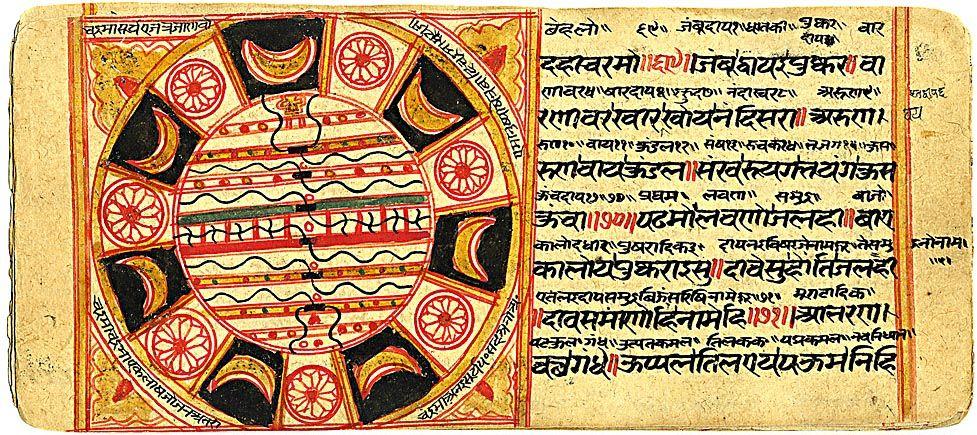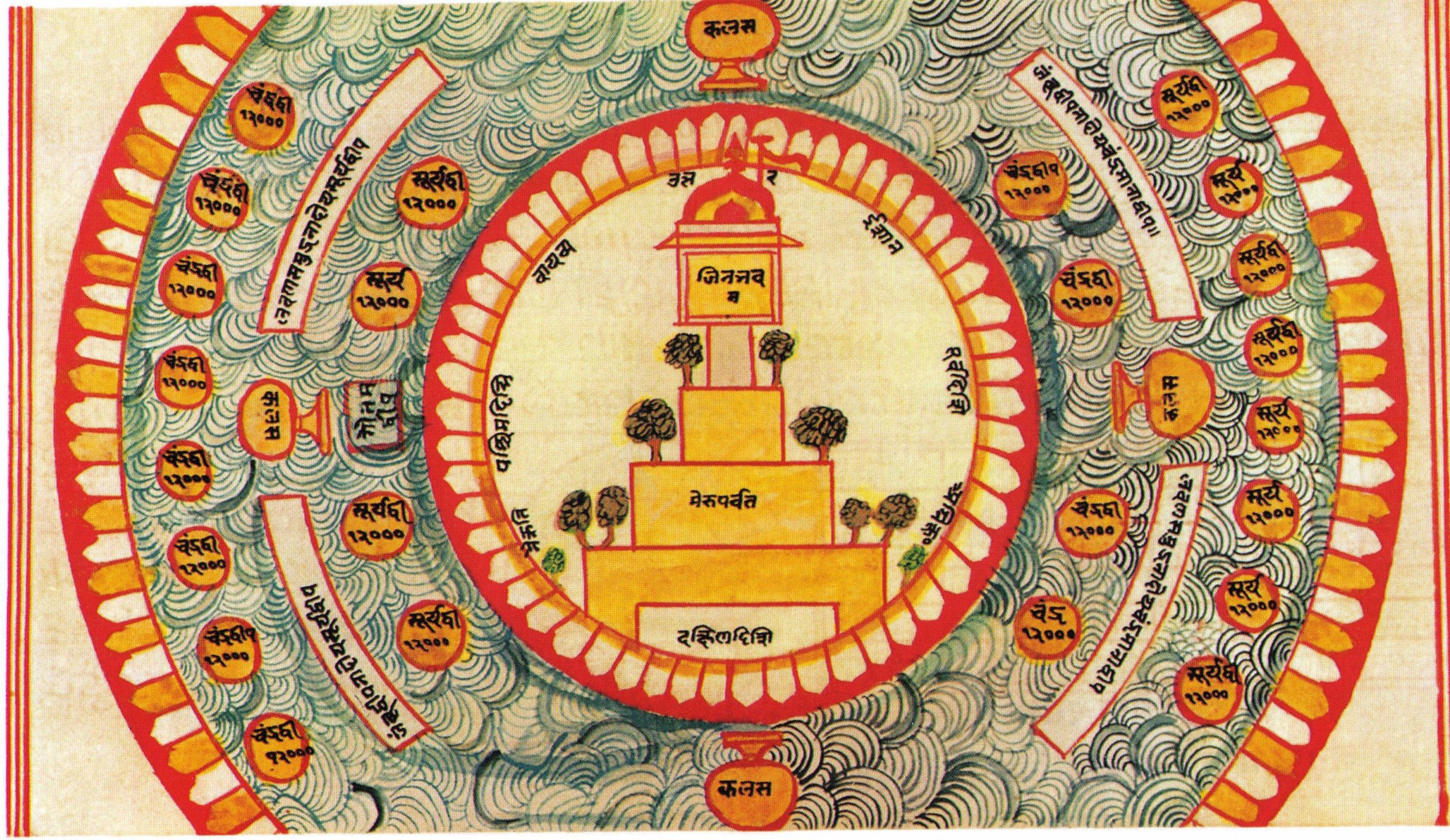Kshetras, Mountains and Oceans
1. Kshetras
Kshetra (area) means a place for human habitation on earth. In Jambudwip, there are seven Kshetras. Between each of two Kshetras are one Varshdhar, i.e. a mountain range. There are six big mountains; the names of the seven Kshetras are:
- Bharat Kshetra
- Hemvant Kshetra
- Hari Varsh Kshetra
- Mahavideh Kshetra
- Ramyak Kshetra
- Hiranya Vant Kshetra
- Airavat Kshetra
The Mahavideh Kshetra is in the middle of Jambudwip. In the south of Mahavideh Kshetra are Bharat, Hemvant and Hari Varsh Kshetras and in the north of Mahavideh Kshetra are Ramyak, Hiranya Vant and Airvat Kshetra.

Sketch of Mahavideh Kshetra (17th century, Gujarat)
- Bharat Kshetra: The God Bharat is the chief of this Kshetra. His life-span is one 'Palyopam' years. Because of the God Bharat, this Kshetra is known as Bharat Kshetra. We all live here in Bharat Kshetra.
- Hemvant Kshetra: This is located between two big mountains called Himvant and Maha Himvant Varshdhar. Hem is Gold. Here, all the equipments are golden. The twins sitting of series of rocks look golden. Hence, this is named Hemvant Kshetra.
- Hari Varsh Kshetra: Hari means both the Sun and the twins here look golden where as the others are silver in their brightness. Hence it is named Hari Varsh Kshetra.
- Mahavideh Kshetra: Videh means body. The size of the body in this Kshetra is comparatively bigger, hence Maha (big) Videh. Besides, the size and area of this Kshetra as compared to others is also bigger. Here religion is the order of the day. The state of mind is also better as belonging to 4th Ara.
- Ramyak Kshetra: The twins of this region have been played and enjoyed in the place of a heavenly tree with golden jewelry on it. That is why, it is known as Ramyak Kshetra.
- Hirnyavant Kshetra: The Rukmi mountain is made of silver, and the Shikhari mountain is made of gold. This Kshetra is located between these two mountain ranges, where the peaks look golden. Hence, it is named Hiranyavant Kshetra.
- Airavat Kshetra: The chief of Airavat Kshetra is God Airavat. Hence it is known as Airavat Kshetra. All the arrangement is like those in Bharat Kshetra.

Sketch of Mahavideh Kshetra (17th century, Gujarat)
2. Mountains
There are six big Varshdhar mountains in Jambudwip. They are #
- Him Vant,
- Maha Him Vant
- Nishadh,
- Nilvant,
- Rukmi,
- Shikhari.
These six mountains are called Varshdhar. Varsh means Kshetra and Dhar means holder. The six mountains hold seven Kshetras in between them, each one making a boarder and limit the Kshetra. They are also called Girikul, where the term Kul means 'community'. Since these six mountains form a community of mountains, they are Kul Giri. Each of these mountains have their chief holding the similar name of respective mountain. These mountains on their east and waste touch Lavan (salty) ocean. Both the ends of the mountain touch east and west end of this ocean.

Sketch of Jambudwip with the mountain ranges (17th century, West India)
At the end of Bharat Kshetra the Khsulla Himvant mountain is four times bigger. Likewise, the Maha Himvant mountain is also four times bigger.

Sketch of Jambudwip with the mountain ranges (17th century, West India)
3. OceansAccording to Jain belief the entire middle Lok (world) is permanently and wheel-like shaped. The middle portion of this have 75% of water the big rivers are almost like big oceans. We have detailed description of oceans, rivers and mountains in Jain scripture in its factual form.
Jambudwip has 1 lakh Yojans area. The Lavan (salty) ocean surrounding it covers two lakhs Yojans. Then, each continent is covered by the oceans of the same name, but twice it size, e.g. Puskar Dwip, Puskar var ocean, Varuni var Dwip, Varunivar ocean etc. Each ocean is twice the size of the continent. There are such 32 Dwips and 32 Oceans. The last ocean is Swayambhu Raman.

Details of Lavan Ocean and islands of moons and suns (18th century, Rajasthan)
It is said that the water of Lavan Ocean is salty, that of Kshirvar ocean tasting like boiled milk, that of Dhrutwar ocean tasting like Ghee, that of Kalodadhi ocean, Puskaravart ocean and Swayambhu Raman Ocean tasting like fresh rain water, that of Varunivar ocean tasting like wine and that of all other oceans tasting like the sugarcane juice. The water of Lavan ocean being salty, cannot be used for drinking by any body except those creatures living in it.